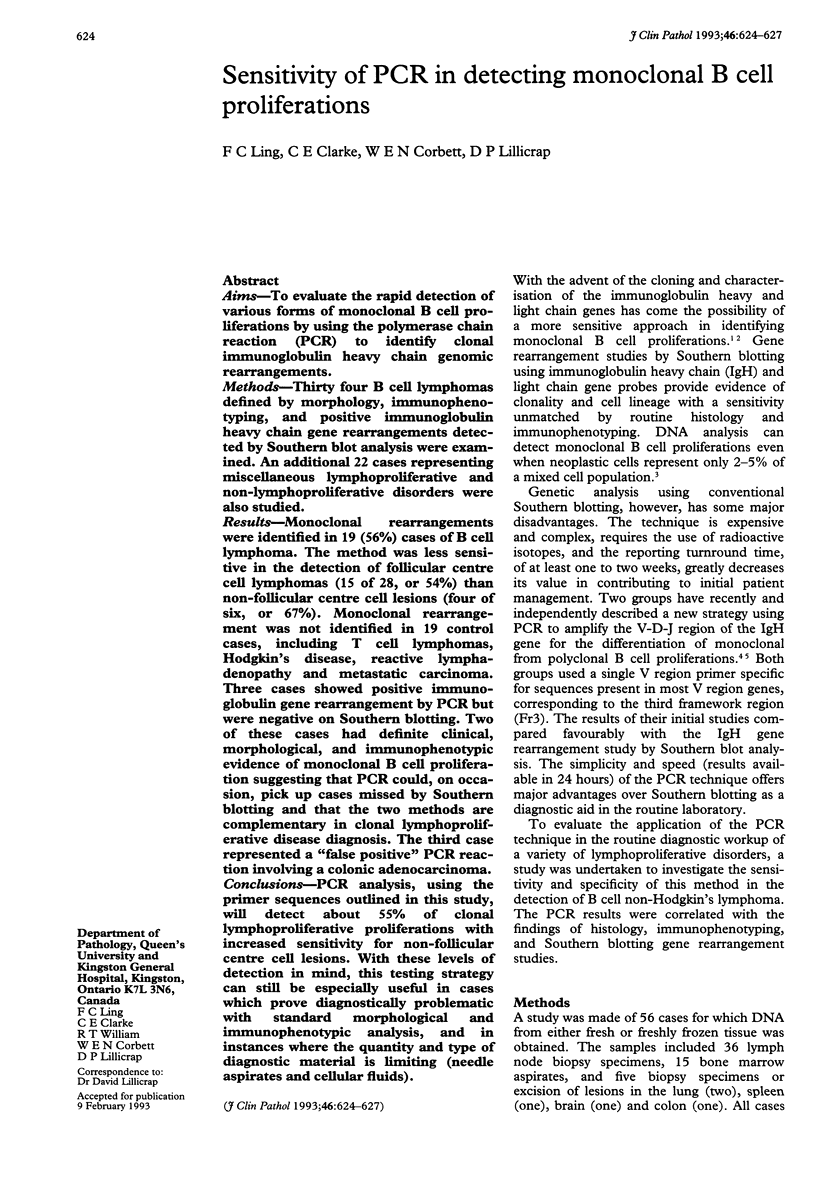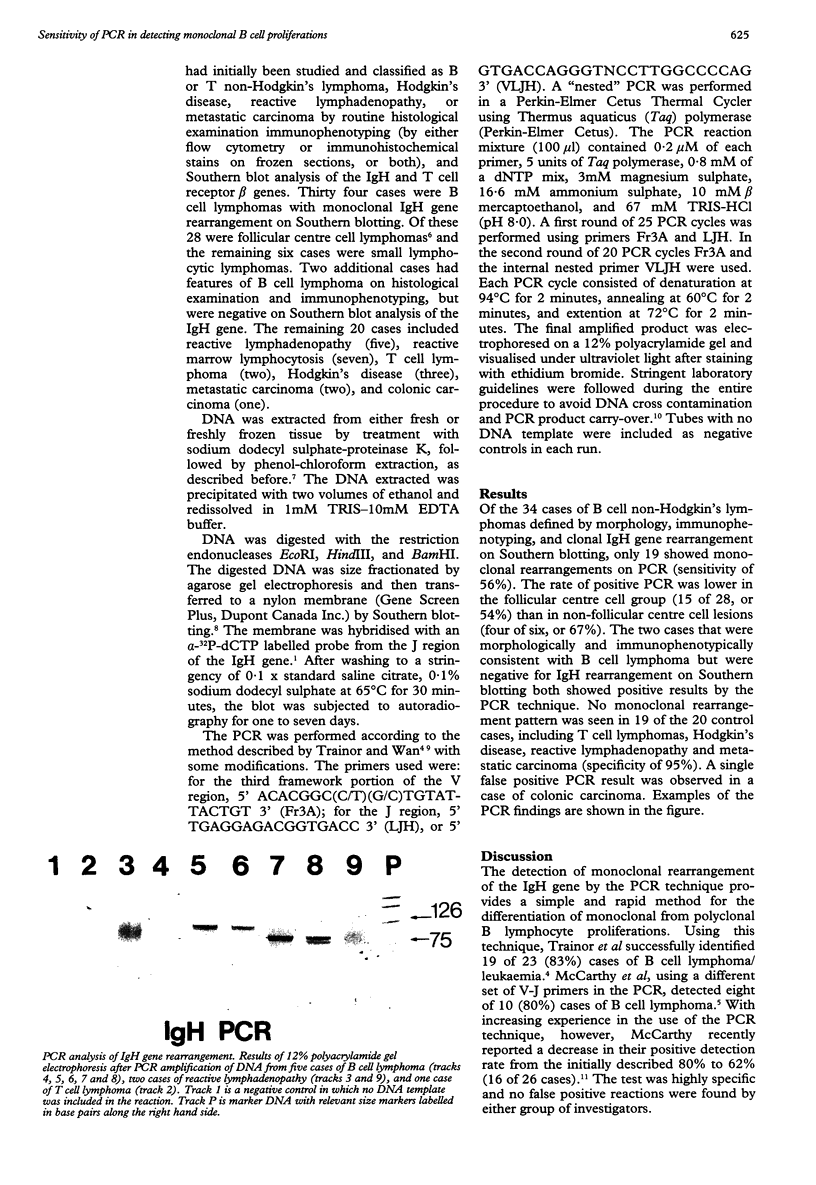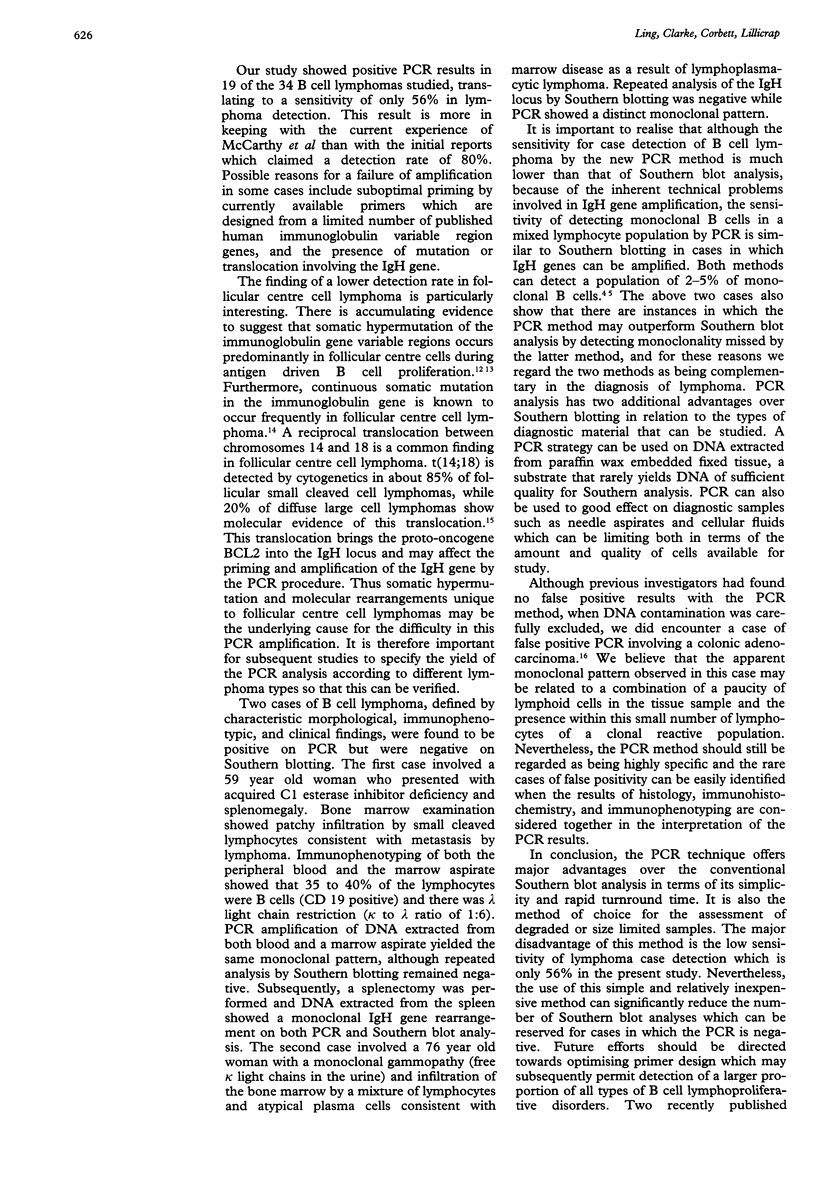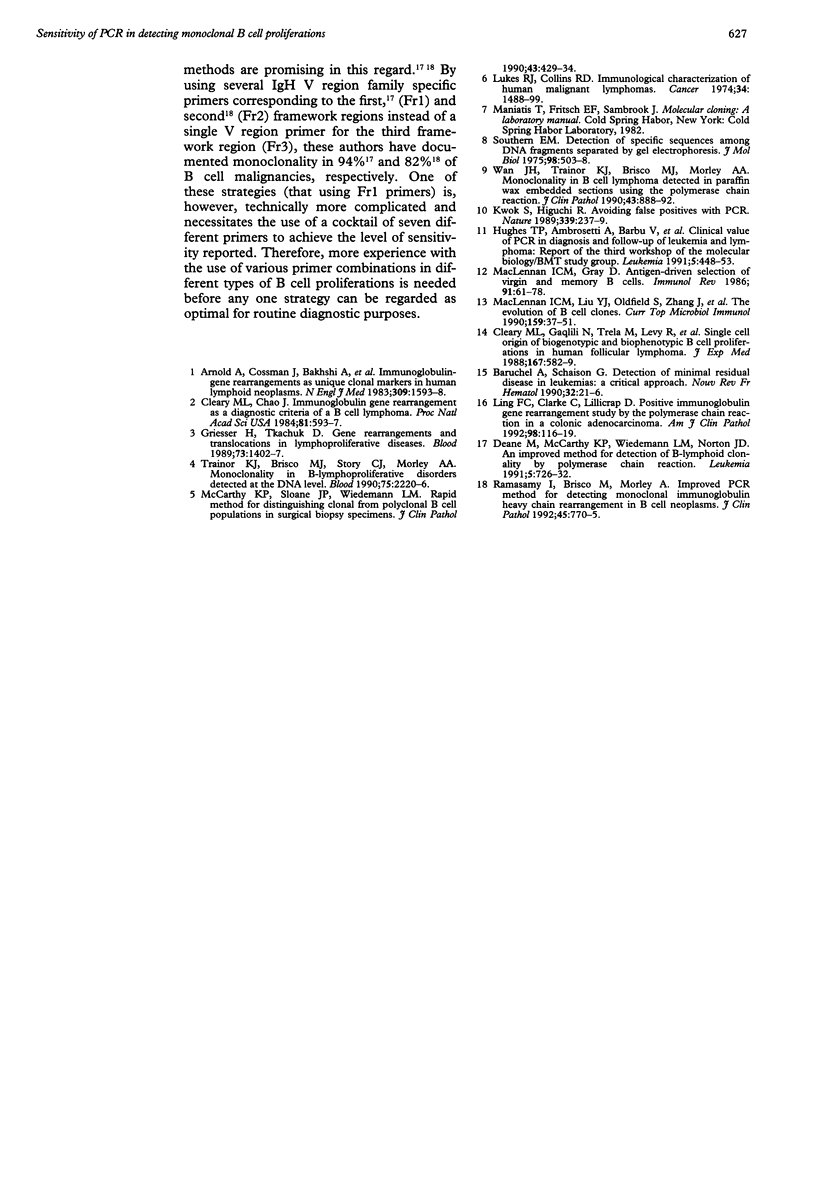Abstract
AIMS--To evaluate the rapid detection of various forms of monoclonal B cell proliferations by using the polymerase chain reaction (PCR) to identify clonal immunoglobulin heavy chain genomic rearrangements. METHODS--Thirty four B cell lymphomas defined by morphology, immunophenotyping, and positive immunoglobulin heavy chain gene rearrangements detected by Southern blot analysis were examined. An additional 22 cases representing miscellaneous lymphoproliferative and non-lymphoproliferative disorders were also studied. RESULTS--Monoclonal rearrangements were identified in 19 (56%) cases of B cell lymphoma. The method was less sensitive in the detection of follicular centre cell lymphomas (15 of 28, or 54%) than non-follicular centre cell lesions (four of six, or 67%). Monoclonal rearrangement was not identified in 19 control cases, including T cell lymphomas, Hodgkin's disease, reactive lymphadenopathy and metastatic carcinoma. Three cases showed positive immunoglobulin gene rearrangement by PCR but were negative on Southern blotting. Two of these cases had definite clinical, morphological, and immunophenotypic evidence of monoclonal B cell proliferation suggesting that PCR could, on occasion, pick up cases missed by Southern blotting and that the two methods are complementary in clonal lymphoproliferative disease diagnosis. The third case represented a "false positive" PCR reaction involving a colonic adenocarcinoma. CONCLUSIONS--PCR analysis, using the primer sequences outlined in this study, will detect about 55% of clonal lymphoproliferative proliferations with increased sensitivity for non-follicular centre cell lesions. With these levels of detection in mind, this testing strategy can still be especially useful in cases which prove diagnostically problematic with standard morphological and immunophenotypic analysis, and in instances where the quantity and type of diagnostic material is limiting (needle aspirates and cellular fluids).
Full text
PDF



Images in this article
Selected References
These references are in PubMed. This may not be the complete list of references from this article.
- Arnold A., Cossman J., Bakhshi A., Jaffe E. S., Waldmann T. A., Korsmeyer S. J. Immunoglobulin-gene rearrangements as unique clonal markers in human lymphoid neoplasms. N Engl J Med. 1983 Dec 29;309(26):1593–1599. doi: 10.1056/NEJM198312293092601. [DOI] [PubMed] [Google Scholar]
- Baruchel A., Schaison G. Detection of minimal residual disease in leukemias: a critical approach. Nouv Rev Fr Hematol. 1990;32(1):21–24. [PubMed] [Google Scholar]
- Cleary M. L., Chao J., Warnke R., Sklar J. Immunoglobulin gene rearrangement as a diagnostic criterion of B-cell lymphoma. Proc Natl Acad Sci U S A. 1984 Jan;81(2):593–597. doi: 10.1073/pnas.81.2.593. [DOI] [PMC free article] [PubMed] [Google Scholar]
- Cleary M. L., Galili N., Trela M., Levy R., Sklar J. Single cell origin of bigenotypic and biphenotypic B cell proliferations in human follicular lymphomas. J Exp Med. 1988 Feb 1;167(2):582–597. doi: 10.1084/jem.167.2.582. [DOI] [PMC free article] [PubMed] [Google Scholar]
- Deane M., McCarthy K. P., Wiedemann L. M., Norton J. D. An improved method for detection of B-lymphoid clonality by polymerase chain reaction. Leukemia. 1991 Aug;5(8):726–730. [PubMed] [Google Scholar]
- Griesser H., Tkachuk D., Reis M. D., Mak T. W. Gene rearrangements and translocations in lymphoproliferative diseases. Blood. 1989 May 1;73(6):1402–1415. [PubMed] [Google Scholar]
- Hughes T. P., Ambrosetti A., Barbu V., Bartram C., Battista R., Biondi A., Chiamenti A., Cimino G., Ernst P., Frassoni F. Clinical value of PCR in diagnosis and follow-up of leukaemia and lymphoma: report of the third Workshop of the Molecular Biology/BMT study group. Leukemia. 1991 Jun;5(6):448–451. [PubMed] [Google Scholar]
- Kwok S., Higuchi R. Avoiding false positives with PCR. Nature. 1989 May 18;339(6221):237–238. doi: 10.1038/339237a0. [DOI] [PubMed] [Google Scholar]
- Ling F. C., Clarke C. E., Lillicrap D. Positive immunoglobulin gene rearrangement study by the polymerase chain reaction in a colonic adenocarcinoma. Am J Clin Pathol. 1992 Jul;98(1):116–119. doi: 10.1093/ajcp/98.1.116. [DOI] [PubMed] [Google Scholar]
- Lukes R. J., Collins R. D. Immunologic characterization of human malignant lymphomas. Cancer. 1974 Oct;34(4 Suppl):suppl–suppl:1503. doi: 10.1002/1097-0142(197410)34:8+<1488::aid-cncr2820340822>3.0.co;2-c. [DOI] [PubMed] [Google Scholar]
- MacLennan I. C., Gray D. Antigen-driven selection of virgin and memory B cells. Immunol Rev. 1986 Jun;91:61–85. doi: 10.1111/j.1600-065x.1986.tb01484.x. [DOI] [PubMed] [Google Scholar]
- MacLennan I. C., Liu Y. J., Oldfield S., Zhang J., Lane P. J. The evolution of B-cell clones. Curr Top Microbiol Immunol. 1990;159:37–63. doi: 10.1007/978-3-642-75244-5_3. [DOI] [PubMed] [Google Scholar]
- McCarthy K. P., Sloane J. P., Wiedemann L. M. Rapid method for distinguishing clonal from polyclonal B cell populations in surgical biopsy specimens. J Clin Pathol. 1990 May;43(5):429–432. doi: 10.1136/jcp.43.5.429. [DOI] [PMC free article] [PubMed] [Google Scholar]
- Ramasamy I., Brisco M., Morley A. Improved PCR method for detecting monoclonal immunoglobulin heavy chain rearrangement in B cell neoplasms. J Clin Pathol. 1992 Sep;45(9):770–775. doi: 10.1136/jcp.45.9.770. [DOI] [PMC free article] [PubMed] [Google Scholar]
- Southern E. M. Detection of specific sequences among DNA fragments separated by gel electrophoresis. J Mol Biol. 1975 Nov 5;98(3):503–517. doi: 10.1016/s0022-2836(75)80083-0. [DOI] [PubMed] [Google Scholar]
- Trainor K. J., Brisco M. J., Story C. J., Morley A. A. Monoclonality in B-lymphoproliferative disorders detected at the DNA level. Blood. 1990 Jun 1;75(11):2220–2222. [PubMed] [Google Scholar]
- Wan J. H., Trainor K. J., Brisco M. J., Morley A. A. Monoclonality in B cell lymphoma detected in paraffin wax embedded sections using the polymerase chain reaction. J Clin Pathol. 1990 Nov;43(11):888–890. doi: 10.1136/jcp.43.11.888. [DOI] [PMC free article] [PubMed] [Google Scholar]



